Everything You Should Add to a Premade Emergency Kit, According to Disaster Experts
- Oops!Something went wrong.Please try again later.

Our editors independently select the products we recommend. We may earn a commission on items bought through our links.
It’s weird to shop for something you hope to never use. Normally, that would be wasteful. Emergency kits are different. They’re like an envelope of money underneath the mattress — forget about it until you need it, and then it will be the most important thing you own.
Today's Top Deals
Disaster preparedness systems, which include emergency kits, are a $146 billion market as of 2020. But many kits are grossly inadequate for a real disaster. They tend to cover the basics, including dehydrated food, clean drinking water, lanterns and emergency blankets. But they usually lack emergency medical supplies, key tools needed to shut off gas or store large amounts of water as well as supplies tailored to specific natural disasters.
A premade emergency kit is better than nothing, and supplementary items can fill in the gaps. Or, better yet, you can purchase all the supplies individually and assemble a kit by hand.
“A kit needs to reflect the disaster you’re preparing for,” said Dr. Caroline Burmon, an Emergency Medicine Specialist at Mount Sinai Beth Israel in Brooklyn, New York who also has a thorough collection of emergency supplies at home. The contents of an emergency kit should be reflective of the types of disasters and emergencies in your geographic area. An earthquake kit stashed in a garage in Southern California can and should look different from one in hurricane-ridden Florida. And anyone who doesn’t live close to a hospital needs to gather medical supplies, a common blind spot in the average emergency kit sold on Amazon.
Both the number and cost of natural disasters in the U.S. has increased in recent years, up 27% just between 2020 and 2019, and hundreds of billions of dollars more expensive compared to just 20 years ago. According to the Annual Preparedness Survey released by FEMA in 2020 of 5,000 adults, only 48% had constructed some form of an emergency plan despite 81% gathering supplies. A similar survey conducted in 2021 by Wells Fargo aligned with this data, showing that while 84% of Americans live in an area that’s experienced at least one severe natural disaster in the last three years, 71%of respondents said they don’t have a detailed plan.
“One of the big differentiating points [in the kits available to purchase] is whether or not you’ll eventually have access to a hospital-like setting,” said Burmon. “A lot of kits assume you will, so you end up doing interventions that eventually necessitate definitive (hospital) care.”
Despite their shortcomings, premade emergency kits are convenient, so SPY has gathered the best ones for the money out there, as well as a list of critical supplies that should be added. Any kit is better than no kit, and t’s worth the extra effort to make sure it’s comprehensive.
Frequently Asked Questions About Emergency Kits
What should I put in an emergency kit?
All emergency kits should cover the basics: shelf-stable food, water, and source of warmth. They should also include things like spare medications, basic medical supplies, a crankable radio, and solar-powered charger. Everyone should also have an emergency plan for meeting up with loved ones that includes a meeting place and communication strategy in case phone lines and other means of contact are unavailable.
What should be in a car emergency kit?
Everyone should also, ideally, have a vehicle emergency kit that’s a smaller, pared down version of the larger one they keep at home. It should also include items that are particularly useful on a long drive like a spare gas canister and jumper cables.
Are emergency kits expensive?
Premade emergency kits can get quite expensive depending on the brand and size you go with. It’s almost always going to be cheaper to purchase your own supplies and construct one yourself that’s tailored to the most common natural disasters in your area and the size of your household.
Where should I store my emergency kit?
Ideally, an emergency kit should be stored in a temperature-controlled environment that’s also easily accessible. A coat closet by the front door or a shelf in an insulated garage are both great locations. It should be easy to access and grab quickly.
What if I just stashed some canned goods and called it a day?
Having something is better than having nothing at all. But in the off chance you’re in a situation in which you actually need an emergency kit you’ll be glad you added a few more critical items.
What to Pack in Your Emergency Kit, According to Experts
Both emergency preparedness experts we spoke to did not recommend premade kits, as they rarely include high-quality equipment and enough supplies to justify the heftier price tags. Instead, they both offered a necessary list of supplies that are easy to purchase and much more worth your dollar than a premade kit.
Astrid Haaland is a Utah-based ER doctor who specializes in wilderness medicine and has been doing avalanche rescues for nearly five years. Both her and Burmon’s lists are very medically focused, but they highlight a critical blind spot in many premade kits.
A SPY-curated selection from both of their lists is included below:
Medical supplies including a tourniquet, trauma bandages, wound powders, occlusive creams, burn dressings, steri strips, surgical cloth tape, and emergency dental supplies
Over-the-counter medicine including Ibuprofen, Benadryl, Pepcid AC
A small nylon cord/paracord 10-12 feet in length
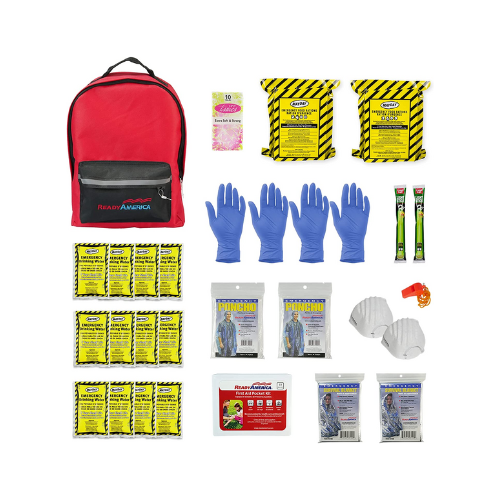
BEST OVERALL
Ready America 72-Hour Emergency Kit
Buy Now On Amazon
This kit is made by Ready America, a nationwide emergency preparedness organization, and includes all the must-have basics recommended by the American Red Cross. This kit doesn’t cover it all, but it’s a solid start. It includes key survival tools like N95 masks, emergency ponchos, emergency blankets, a basic first aid kit, drinking water, and food rations. It works for two people for three days, so it’s not recommended for larger households or families, but it can serve as an excellent jumping off point for adding other necessities.

BEST SPLURGE
JUDY Mover Max Emergency Preparedness Kit
Buy Now On Amazon
Made For: Small households that don’t mind investing more money
ROI: The ROI on this kit is lower than it could be given the needlessly high price point, but it includes all the basic supplies recommended by the Red Cross organized into three sections: food, warmth and first aid, and it’s enough to sustain up to four people for 72 hours.
Hot Take: This kit coming in a dry bag is the best thing about it. Wet emergency supplies become much less useful very quickly, so it’s a helpful touch especially for those who live in hurricane zones.
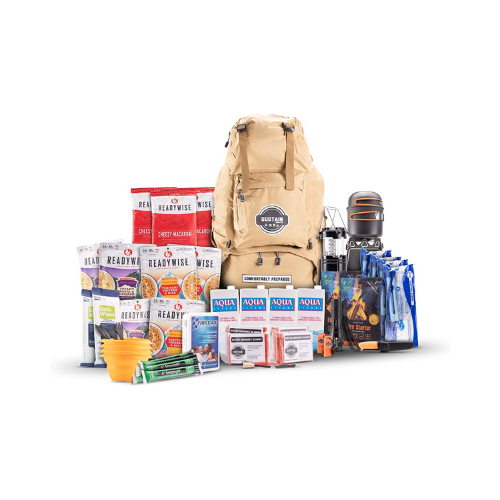
RUNNER UP
Sustain Supply Emergency Survival Kit
Buy Now On Amazon
Made For: This kit is perfect for those who don’t live in an area prone to severe natural disasters, but still want something in case sheltering in place becomes necessary.
ROI: This kit, like all the others, requires the addition of more medical supplies and other equipment, but compared to nothing the return on investment will be high.
Hot Take: This larger backpack kit is better than smaller, more streamlined kits because it can carry more without being too much for one person to take on.

BEST EMERGENCY WHISTLE
Shoreline Marine Emergency Whistle
Buy Now On Amazon
An emergency whistle is a simple tool, but in many disaster and rescue scenarios the ability to alert someone of your presence can be the difference between life and death. This one is designed to produce a loud sound wet or dry and comes with a neck lanyard for convenience.
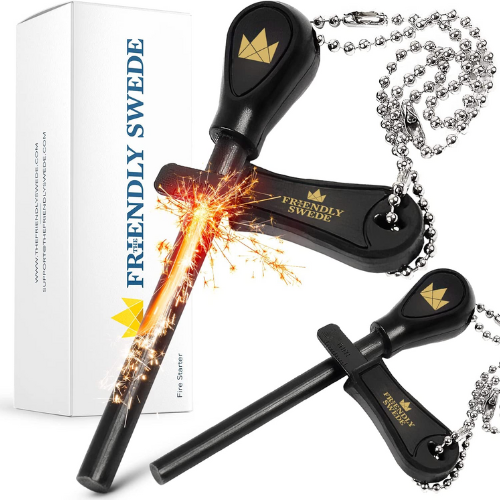
BEST FIRE STARTER
The Friendly Swede Fire Starter
Buy Now On Amazon
A fire starter is a key addition to any emergency kit, and these alloy firestarter rods are made to work in any conditions, are ultra-durable, and made of rust-free ferrocerium designed to not bend or break even with regular use. They’re extra long, so they’re easier to strike with to create more sparks and they’re built very compact.
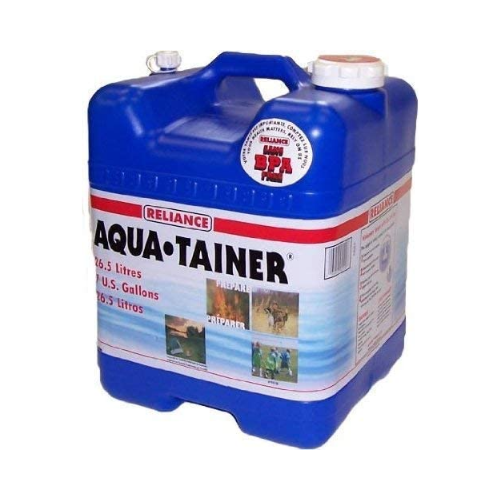
BEST WATER CONTAINER
Reliance Aqua-Tainer 7-Gallon Water Container
Buy Now On Amazon
Saving water at home is an apocalyptic vibe, but in today’s world being cut off from access to clean drinking water is definitely not out of the question. This container can hold seven gallons at once and has a molded grip so it can be moved from place to place if needed. It has a spigot for easy dispensing and it’s got a design for stacking so multiple can be stored vertically with ease.
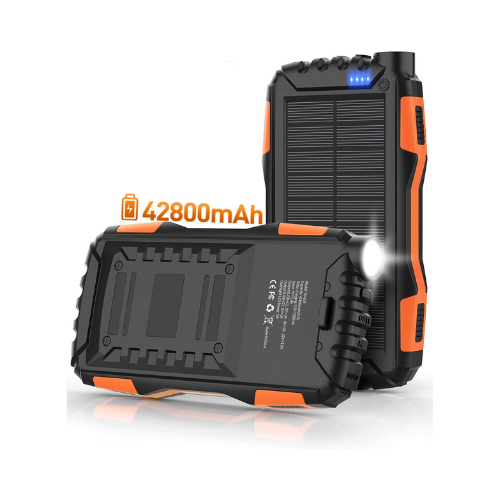
BEST PORTABLE CHARGER
Mregb Solar-Power Bank
Buy Now On Amazon
Regardless of the type of natural disaster, one of the most likely scenarios is being cut off from power. Charging a cell phone can be not only convenient but life-saving, so a solar-powered portable charger could definitely come in handy. This one has a large charging capacity of 42,800 milliamps her hour (mAh), and comes with two USB ports for charging smartphones and tablets simultaneously.
More Top Deals from SPY
Best of SPY